#historical working class fashion
Text
I watch a fun IG reel of a maid getting dressed in 1790 vs. 1890. it's great! both maids are in practical, period-typical outfits with a few simple aesthetic touches because Humans Like Looking Good regardless of social class. you can tell they are maids because they put clearly functional aprons on, and the 1890s one is wearing a uniform-style cap. also the caption says they are. love it
I scroll down
the top comment: "but what did POOR women wear? you only ever show rich people's clothes!"
#dress history#fashion history#historical costuming#perhaps...working women...had nicer clothes than you realize?#perchance they...did NOT go about in rags?#shocking to even consider I know!#also if they're not being educational historical costumers don't owe you working-class ensembles in their fun personal hobby#but that's another conversation#(I'm a normal person 24/7! let me be a countess for a while!)
795 notes
·
View notes
Text


#working class fashion babeyyyyy!!!!!!!#hell yeah 😎😎#historical fashion polls#fashion poll#historical dress#historical fashion#dress history#fashion history#fashion plate#19th century#19th century fashion#19th century dress#early 19th century#1820s fashion#1820s#1824
69 notes
·
View notes
Note
Hi! So I’m doing a personal art project on fashion in the 1890s, and I am struggling. Like a lot. I created a Pinterest board of a bunch of 1890s dresses, problem is I’m having a hard time identifying the uses for some of them. I know that a Walking dress is a type of Day Dress but how exactly would one differentiate the two? What exactly would be the physical differences between a Walking dress and a Day dress?
And did everyone have walking dresses? Or was the more of an ‘upper class’ sort of thing?
I understand the struggle. It was quite hard to parse out at first for me too since the Victorian dress etiquette was pretty complex. Fortunately I have made a post about that specifically for 1890s. If it doesn't answer all your question or you want me to specify something, feel free to sent another ask! I used examples from different years of the decade to make it more applicable to the whole decade but it should be remembered that there was changes to the silhouette thorough the decade and every type of dress would be adapted to the shifts in the fashionable silhouette.
Though as I point out in the post it focuses on the upper class. For the working class and to some extent middle glass it was a little different. The working class did not participate in the high society events, but many middle classes could at least to some of them, and working class women worked outside of the house too, while married middle class women generally didn't. Young unmarried middle class women did often work, for example as secretaries and shop assistants in respectable establishments. Working women didn't spend their days receiving guests at tea parties or attending them, so they didn't have tea dresses, nor did they generally have evening gowns which would be required in formal high society events. They might have a dinner dress though if they were well off, which was the least formal of evening gowns. Middle class women would generally have these. Working class and the casual middle class day dress resembled much more the walking dress of the upper classes than their other day dresses. They would have a church dress that would be a little fancier day dress for church and usually even fancier day dress for formal functions, like weddings.
Here's working class women in their work attires that were practical day dresses and aprons usually.

And here's middle class women in fairly similar dresses.
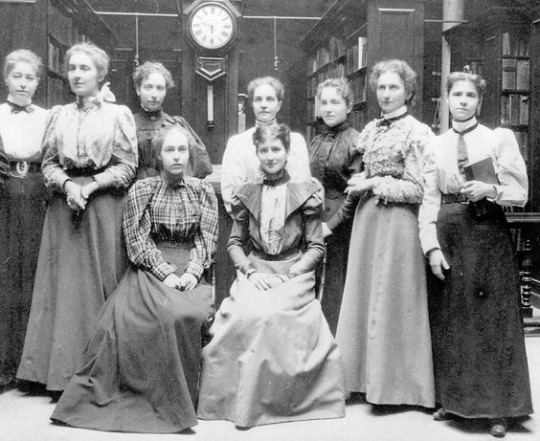
Different types of day dresses
Maybe I should expand more on the differences in day dresses and how walking dress relates, since while I talk about day dress and walking dress separately in the linked post, I don't fully explain the whole day dress thing since I did need to simplify. Day dress was not a specific dress, but quite a broad category of dresses that were used in different situations thorough the day. They are quite hard to differentiate sometimes, mostly because they weren't really that strictly different from one another. To understand why one dress was used in one situation, we need to understand the dresses in the casual to formal scale. Usually casual is looser, more practical, less elaborate and more covering but has shorter hem and the opposite apply to more formal.
When staying at home, people would be in their most casual clothing, but the level of formality would rise when receiving guests. Leaving home would require higher level of formality, but how high would depend on what you were going to do and who would see you doing it. This is why visiting gown is more formal than the dress the hostess would receive their visitor in. Close family members and friends could be casually received outside specific events during the day and a casual house dress or tea dress was acceptable for that. Afternoon tea was an important social event for upper and middle class women, and it would be slightly more formal occasion, but still for family and friends and therefore somewhat casual. Visiting dress were on the formal end of the afternoon dresses, but more casual versions of it could be used to go see a close friend or family member in a more casual way. Carriage dress was worn for open carriage rides, which were social events for the upper class. There they would be seen prominently by their whole community while they socialized in the carriage among their peers. Carriage dress was therefore very formal and elaborate, often had a trail and usually had a cloak as the wind might get cold. Promenade dress was for walks in a park. This was different from an actual walk, as the upper class people would go to a park to be seen and to socialize. Promenade dress was then somewhat formal, though less than most visiting dresses or carriage dress.
Here's first an example of a quite elaborate visiting dress from 1894-95 and then carriage dresses, first image from 1894, second from 1891.
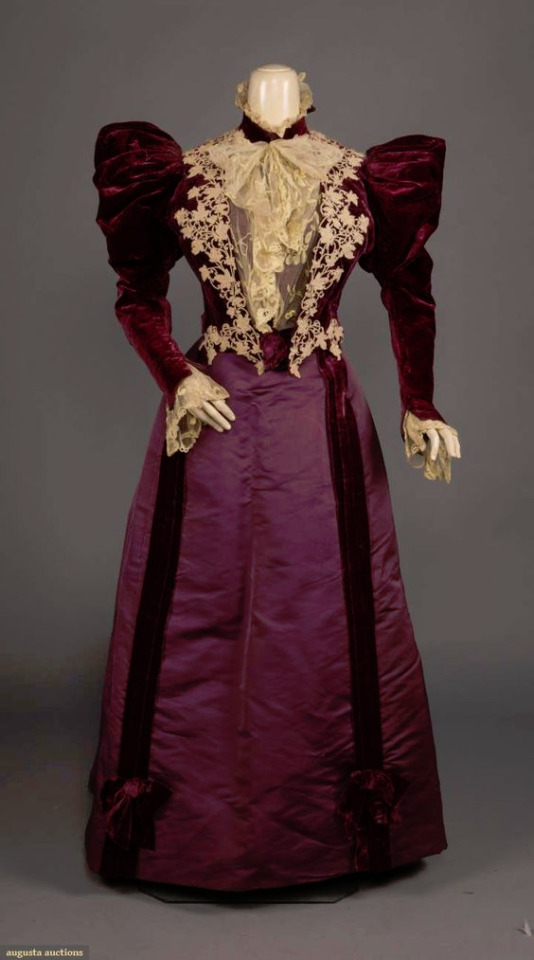


Walking dress was the least formal of the dresses an upper class person might wear outside the house (excluding sports dresses). It was used by upper class people for city walks and traveling, but as I said earlier the practical day dresses of middle and working class were very similar to it. It was practical and simple. It had shorter hem, it was made from sturdy materials, often wool and it was usually tailored. Dress Reform Movement, which was a moment among the first wave feminists, advocated among other things for tailoring in women's clothing, arguing it was more practical. The trend begun in 1880s and it's really most prominent in walking dresses and sports wear of 1890s. Which it why the walking dress typically has a lot of elements from men's fashion. Unlike the other day dresses, which were rarely tailored and had usually just the skirt and the bodice, the walking dress had a skirt, shirtwaist, tailored jacket and sometimes a waistcoat and a tie or bow. Sometimes a walking dress is hard to distinguish from a promenade dress. Promenade dress was more elaborate and while it usually had a shorter hem than for example carriage dress, it wasn't as short as for a walking dress and it might even involve a bit of trail. The things is promenade dress and walking dress probably had a lot of overlap.
Here's fashion plates showing promenade dress styles, first from 1896, second from 1898, both conveniently showing an elaborate dress and a tailored look that's easy to get mixed with a walking dress, and possibly would have been used as such in some cases.
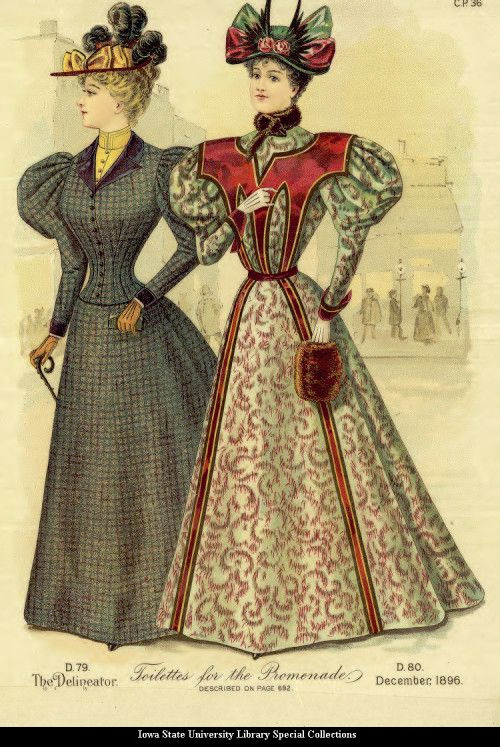

Here's walking dresses shown in a picture from 1899 (note the early photoshop to make the waist smaller), a fashion plate from 1896 and a painting from 1897. Really the main difference is the hem of the skirt to the promenade dresses of tailored style.



Shirtwaist
I will mention on it's own shirtwaist too, since it highlights a lot of the class differences and how they showed. The shirtwaist, or blouse waist or sleeve shift, is a hard garment to pinpoint as it was used for many different purposes by different people. It was one of the first garments to be mass-produced and therefore very affordable. It was also loose and unfitted by nature and so easy to move in. For these reasons it was used with a practical skirt by working class and middle class women as casual wear. The outfit was sometimes used with a jacket similar in style to those of walking dresses, making it practically indistinguishable from a walking dress. Here's for example pictures of working women class women wearing shirtwaists at work and at town shopping (the other picture could be of middle class women too).


As tailored styles influenced by men's fashion became popular, so became shirtwaists. At the same time sports were becoming popular and sportswear was highly influenced by this tailored trend. Shirtwaist being light and loose was perfect for sports and was used by upper and middle classes for tennis, golf and cycling for example. (I'm working on a post about the history of tennis ensemble where I go deeper into this.) Because of it's very casual nature, it was not considered suitable for the upper classes in most situations outside sports. As seen above it was part of the walking dress for the upper class, but in that situation it was used under a jacket. Young fashionable progressive women, who were often called the New Woman, started using it in their morning dresses and then even casual day dresses.
Here's first a picture of tennis ensemble from latter half of 1890s, a picture of young women from 1898 and a fashion plate from 1898.
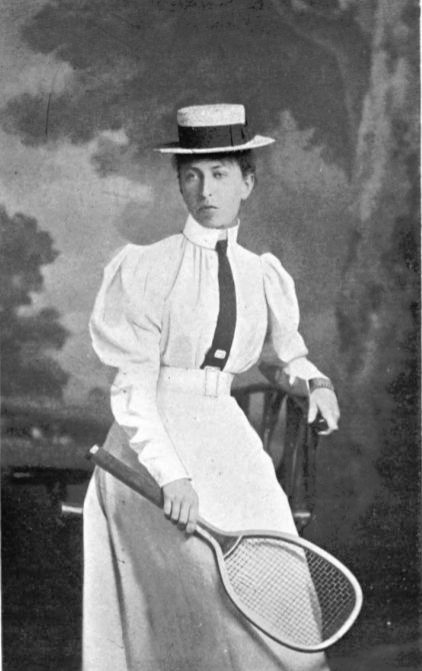

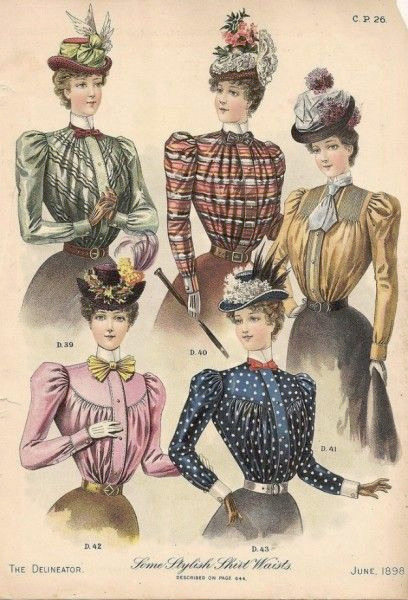
I have a pinterest board of primary source examples for Victorian fashion, where I've made a rough divide between different periods of the era and different types of dresses inside every period. It's not fully organized yet and at least for now the types of dresses are divided very roughly into day dresses, evening dresses, sports ensembles and toilette. Toilette is a vague enough term so I used it here to include basically any dress used exclusively at home. The categories are maybe not granular enough to be helpful for you here, but I'm linking it here in hopes it would be of some help.
#answers#historical fashion#history#fashion history#victorian fashion#dress history#1890s fashion#victorian day dress#1890s day dress#day dress#working class dress#anon
185 notes
·
View notes
Text
if i have to see one more tightlacing scene in a piece of media taking place in the fucking 1810s i am going to lose it
you know what 1810s stays looked like???

like that. notice how the natural waist barely goes in.
do you wanna know what the fashionable silhouette was???

now. now. look me in the fucking eyes. DO YOU THINK YOU CAN TIGHTLACE YOUR RIBCAGE? BECAUSE THATS WHERE THAT WAIST WAS. THERE’S NO POINT TIGHTLACING BECAUSE YOU CANT FUCKING SEE THE GODDAMN NATURAL WAIST.
thank you for your attention
#historical accuracy#also. buddy.#working class people didnt tightlace generally#you know how celebrities get like. two ribs removed or whatever#thats tightlacing#you dont have time for that if you have to work#shaking costume designers and show writers#everyone look at emma (2020) they did an amazing job#yes this is about bridgerton#and i realise theyre not trying to be historically accurate#but PORTIA whats the POINT tightlacing your poor fucking child if youre gonna put her in a fashionable dress
82 notes
·
View notes
Text
This paper is actually going quite well.
Too bad it's complete bullshit.
#I'm not lying#but I'm definitely not being brutally honest about the historiography here#look the first few works are technically all social histories but there's a qualitative difference from the later ones#and the politics is still important enough that I should get to call them political histories#Also frankly I don't care#I just need to finish the damn paper by midnight and then I will be free of this fucking course#I have never in my LIFE dreaded going to class before this course#And honestly? It's soul crushing! I have no will to succeed here!#My only motivation is that I liked the rest of the semester and I need to pass this class to continue the program!#the professor asked for an additional evaluation (still anonymous) and I'm torn about how brutal to be#because on the one hand it was an enlightening course and I am definitely better equipped as a historian than I was three months ago.#on the other hand every single one of my classmates had completely given up by the end because no matter what we did it wasn't good enough#and also the professor was just fucking mean a whole bunch. But in that subtle way where you feel crazy for noticing.#so the class was horrible but I don't want him to feel horrible but also maybe he deserves it??? I can't even tell if he's actually a dick#or just acts like one#which is perhaps not a meaningful distinction but if he doesn't mean to I'd feel bad being too harsh#though several incidents make me think he meant to#blegh. It'll all be over by midnight!#And then I can focus on studying for women's history and - joy of joys - writing a syllabus about Victorian fashion and politics#I fucking love historical fashion that's going to be absurdly fun
2 notes
·
View notes
Note
Hello there I had some questions and thought you might help. When did men’s clothing start the transition from breeches to trousers? What was the average man wearing at the start of the 1820s vs a fancily dressed gentleman? And by 1830 had breeches totally gone out of style? Thanks for your insight!
It's easier to answer this question for a fancy gentleman, as dress history books are generally focused on lifestyles of the elite; even though trousers were initially worn by working class men. Farid Chenoune writes in A History of Men's Fashion:
The affluent classes had been dressing their little boys as "sailors" ever since 1770 or so, in long, comfortable pants that buttoned to a short jacket. Liberation from this costume signified the end of childhood. Sailors' and workers' pants had not yet breached the barriers of age and class, however, so French revolutionaries in 1792 were defined not by what they wore, but by what they did not wear—sans culottes meant without breeches.
During the same decade, on both sides of the English Channel, casual yet elegant morning dress began to include clinging pants known as "pantaloons". [...] Brummell began wearing them in the evening as well around 1810—black, tight, buttoned above the instep. In 1815, the Prince of Wales, after having forbidden pantaloons, allowed them at court.
Pants—in the form of pantaloons or trousers (which were more casual and, though occasionally tight-fitting, never clung to the calves like pantaloons)—definitively ousted breeches during the Restoration and the 1820s.
"Definitively ousted" maybe isn't the least controversial statement. According to Valerie Cumming, trousers didn't completely replace breeches for formal evening dress until 1850 (The Dictionary of Fashion History). Joseph Couts' A Practical Guide for the Tailor's Cutting-room (1843) has an illustration of men in evening costume, with one wearing breeches.

More specific to the 1820s, The Handbook of English Costume in the 19th Century states that in that decade, "Breeches were correct for Court wear; for ordinary evening costume, pantaloons or pantaloon-trousers."
(Pantaloon-trousers are "strapped under the foot and sometimes buttoned up a side slit").

Straps and buttons: 1827 fashion plate.
The Handbook of English Costume in the 19th Century (C. Willett Cunnington and Phillis Cunnington) is a great reference because it quotes and reproduces primary sources. Breeches are cited in very formal Court dress, wedding dress, and in hunting or riding costume (pantaloons could also be worn when riding).
Until 1820 both breeches and trousers continued in vogue, the former were always worn at Court and on formal occasions but the latter steadily gained in popularity. [...] when George IV came to the throne in 1820, he gave a definite lead towards the adoption of trousers for wear on all occasions.
— Doreen Yarwood, Illustrated Encyclopedia of World Costume
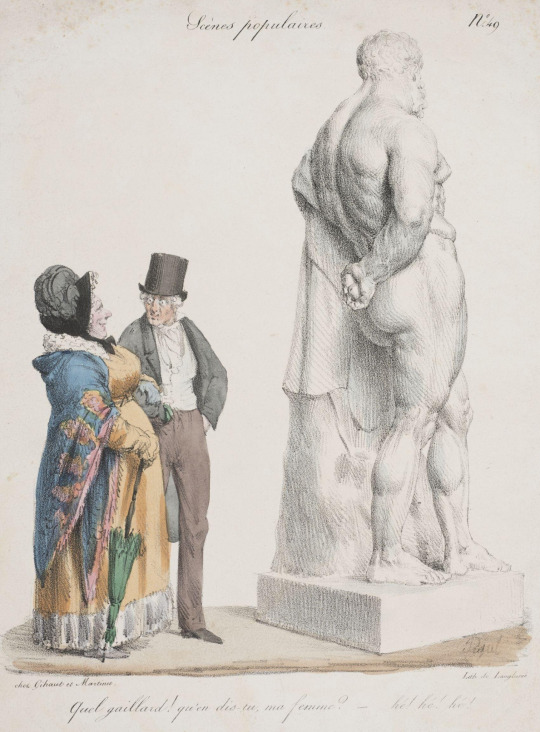
Even the older gentleman wears trousers, not breeches, in this c. 1822 print. (Then again he's also French, and gleefully checking out the greatest assets of a statue of Hercules).
The same rules apply by 1830, for a fancy gentleman: he would wear trousers, not breeches, except possibly on the most formal occasions (and even then, he might wear pantaloons instead). Liveried servants often wore breeches, but in their case it's an old-fashioned and traditional uniform, and not fashionable.
I think the "average man" of the 1820s would also be wearing trousers. Working class people still dressed much like the upper classes in the 19th century, as others have pointed out, unless they were crushingly poor. They would simply use cheaper fabric, less ornamentation, and alter and repair clothing more than wealthy people.
Still, you occasionally see breeches in the 1820s working class, like this 1825 watercolour by George Scharf of Old Covent Garden Market (British Museum):

Most men appear to wear trousers, however.
I would love to get my hands on more of the plates from Frederic Shoberl's 'The World in Miniature' series, published 1821-1827. It covers various foreign countries in different volumes (and some of these are on Archive), but also English working class people, like this bricklayer's labourer (source):

He appears to be wearing both breeches and gaiters (occupational dress?), but the men on scaffolding in the background have long trousers.
#1820s#fashion history#men's fashion#historical men's fashion#trousers#breeches#pantaloons#dress history#working class#i was going to be nice and put a readmore#but nah#Eighteen-Twenties Tuesday#long post#thanks for the question!#asks#also sorry i managed to get greasy 1840s men in this answer#but not that sorry#george iv#beau brummel
29 notes
·
View notes
Text
the monarchy should be replaced by shirley collins. a real english institution
#just read a new interview with her in which she reiterates that one of her motivations for cataloguing and sharing traditional songs#is to preserve the historical memory of the culture of real working-class britain#to paraphrase apparently the early 60s middle class folksinger london scene dismissed her for her origins as she says#'how presumptuous of me to believe that i could participate in the music that came from my own class of people passed down over the years'#but apart from that it's like. yes sing in that angelic old-fashioned voice about tragedy and turmoil and murder. we love you#also her current 93 collab? i love elderly people sometimes. bees and butterflies pecking out its eyes#jamie.txt
3 notes
·
View notes
Text

OP has made the original post non-rebloggable, presumably because @marzipanandminutiae reblogged it with this very fair explanation:
Yes, but you’re not living in a world where looking up-to-date in at least basic silhouette and outfit composition (within, say, 5 years of the current fashions) was considered an element of respectability in most settings, and your social standing- and therefore your job prospects, marriage prospects, or husband’s career as relevant -could suffer if you didn’t keep up. Only the very VERY wealthy/socially secure could buck the rule (or people destitute enough to have nothing to lose, I suppose)
It’s socially acceptable to wear clothing you had as a teenager NOW. That wasn’t always the case
... but I wanted to add this bit of extra information I find interesting. Looking at 18th century gowns in particular you tend to see quite a lot of this:


and this

While the details changed, the basic shape and structure of gowns in the 18th century stayed much the same for a long time, meaning that crisp, high quality fabric could easily be refashioned into a more up-to-date dress in order to save money. However, past a specific point (generally the 1780s) they stop being altered. The fashionable silhouette for women changed radically after this point, becoming softer and simpler. It was out with the stiff taffeta and in with gauzy muslins.
You see a lot less upcycling of materials in the 19th century, most likely because of how bodice and skirt shapes changed so wildly between decades (not to mention fashions in colours and trimmings, though these were far easier to alter and many people did). I like this example though:
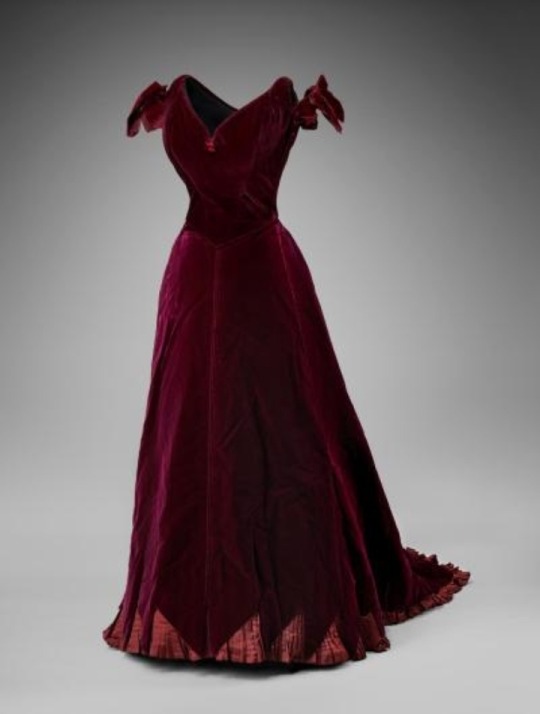
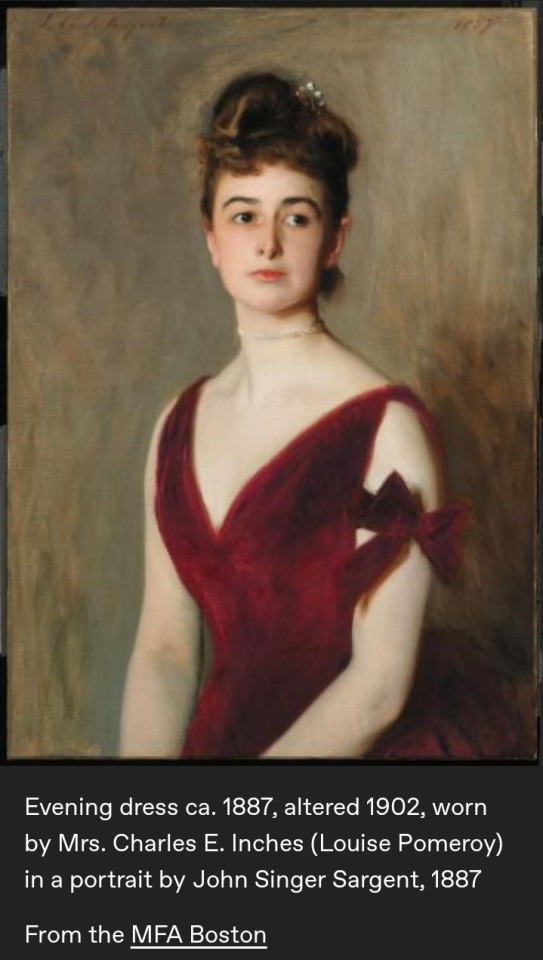
Of course, all of these examples involve the re-using of good quality fabrics, i.e. those belonging to relatively well-off people. There's no reason to believe that poorer women throughout history wouldn't have re-used fabric in this way. If anything, they would have re-used it into oblivion: an adult skirt cut down for a child, or window curtains, or a quilted bedspread, with worn or stained or many-times-mended areas becoming rags used for cleaning or sanitary towels. Surely, then, only wealthy women would have made sure they weren’t wearing clothes from an earlier decade?
The answer to that is: mostly no, but it depends on the time and place. In the early part of the 19th century
[in] the villages of the north-east, some women wore quilted petticoats that had been fashionable wear in the 1760s. Women in most other parts of the country had long abandoned these garments, but they were still popular, and widely made by the fishermen’s wives along this stretch of coast, because the locals had come to think of them not as old-fashioned garments but as part of a style unique to themselves. Welsh women, too, often had a regional identity and were well known for their tall black hats and red shawls, and also for their preference for using the local striped wool cloth to make their skirts. Irish women, different still, were often characterised by bare feet and short, knee-length skirts. The fast-growing fashions of London coexisted with traditional dress in all these communities, but local considerations still endured. A woman in the Rhondda Valley might well have found that the cheap printed cottons so abundant in Cheshire and Hertfordshire were not so readily available to her as the coarsely striped local wools. Tradition also played its part, and their were provincial fashion leaders who held sway in small areas. To wear the clothes of one’s community could make a person feel closer to their home; looking like an English outsider sometimes held little appeal. As the railways pushed their way into every corner of Britain, some of these local considerations began to have less influence. Materials became more evenly available, and people moved around more often. In 1861, the tax on paper was repealed, and this, along with a series of technological leaps forward in the printing industry, made books, magazines, flyers, catalogues and posters significantly cheaper and more prolific. Fashion information was one of the boom areas of print, and served to standardise aspirations across the country.

An 1859 fashion plate from Godey's Lady's Book (a popular 19th century magazine) showing crinoline fashions. Beginning in 1853, almost every issue also included an illustration and pattern with measurements for a garment to be sewn at home.
For those for whom even the ready-to-wear market was just too expensive, and for whom occupational or regional dress had little meaning, clothes still carried one important cultural message. Were you a member of the ‘respectable poor’, or were you one of the desperate? As long as you could keep up appearances, there was hope, but sink below the acceptable level of clothing standards and doors would be slammed in your face, opportunities closed off to you.


Working class women in 1803 and 1805. While aristocratic ladies wouldn’t have been seen dead in these cheerful printed fabrics, which were cheap and plentiful, the shapes closely follow the fashionable silhouette of the time
But what about the lowest of the low, those inmates of what must be the last word in popular conceptions of Victorian poverty: the workhouse?
Each workhouse union was free to choose its own uniform. Most remained roughly in line with the general styles of working-class clothing of the period, erring towards the old-fashioned… The fabrics were among the very cheapest of the day and, with only cotton fabrics covering the upper body, would not have been very warm. Having two chemises, two jackets and two pairs of stockings, the women could maintain a reasonable level of cleanliness with one set on and the other in the wash… Women’s clothes within a workhouse were usually made up by the women themselves, which might suggest that they were allowed to make sure they fitted, but in practice this was usually frowned upon by the management, who preferred to set sizes so the clothes were interchangeable. A woman would therefore wear whichever garment was handed to her from the week’s wash, rather than having her ‘own’. Some of these uniforms were scarcely updated throughout the entire history of the workhouse, which made workhouse clothing increasingly anachronistic and even more noticeable to those outside. A photograph of St Pancras workhouse in London taken at dinner time in 1900 shows hundreds of forlorn women sitting in rows dressed in a baggy version of 1850s dress.
(Above quotes from Dr Ruth Goodman’s How to be a Victorian)
Tl;dr: if you were a working adult (and let’s remember that the majority of adults in the UK were working), you needed to look respectable. This meant keeping vaguely up to date with current fashions in outerwear, even if that necessarily meant using plainer or more hard-wearing fabrics, and making other changes in order to be practical for one’s own life (all women in the 19th century wore corsets, but if you weren’t a fine lady with nothing on her to-do list that day except for sitting for Mr Singer Sargent you wouldn’t tight-lace).
Before the mid-20th century, people were far more attuned to the subtleties of clothing than we are now, and what it could supposedly tell you about people. Fashions changed more rapidly and more radically in the 19th century than ever before, thanks to advances in manufacturing and the dissemination of media, but also at least partly so the wealthy could stay ahead of the working poor and lower middle classes. If you could afford it, you made sure you were as up-to-date as possible, as well as being clean and neat, as a matter of personal pride. It’s an attitude that can feel rather alien now, in a world of style subcultures, where the cycle of what is considered fashionable has narrowed spectacularly: the structure, materials, and manufacture of today’s clothes haven’t changed much for forty years, aside from the slow (and still fairly niche) rise of more sustainable materials. Details change, of course, but OP can still wear items they bought in high school, whether that was last year or ten years ago, because, providing they aren’t damaged or stained, they look much the same as items being made now. Bizarrely, that makes us far more like the Georgians with their re-used gowns than 19th century or 20th century people.
#19th century#victorian fashion#18th century#georgian fashion#historical fashion#illustration#vintage#I haven't gone into a bunch of stuff like heirloom jewellery or the way even working class people had ruffs in the 17th century#I thought this was probably long enough already#long post
5 notes
·
View notes
Text
So I accidentally almost got into an argument on Twitter, and now I'm thinking about bad historical costuming tropes. Specifically, Action Hero Leather Pants.
See, I was light-heartedly pointing out the inaccuracies of the costumes in Black Sails, and someone came out of the woodwork to defend the show. The misunderstanding was that they thought I was dismissing the show just for its costumes, which I wasn't - I was simply pointing out that it can't entirely care about material history (meaning specifically physical objects/culture) if it treats its clothes like that.
But this person was slightly offended on behalf of their show - especially, quote, "And from a fan of OFMD, no less!" Which got me thinking - it's true! I can abide a lot more historical costuming inaccuracy from Our Flag than I can Black Sails or Vikings. And I don't think it's just because one has my blorbos in it. But really, when it comes down to it...
What is the difference between this and this?
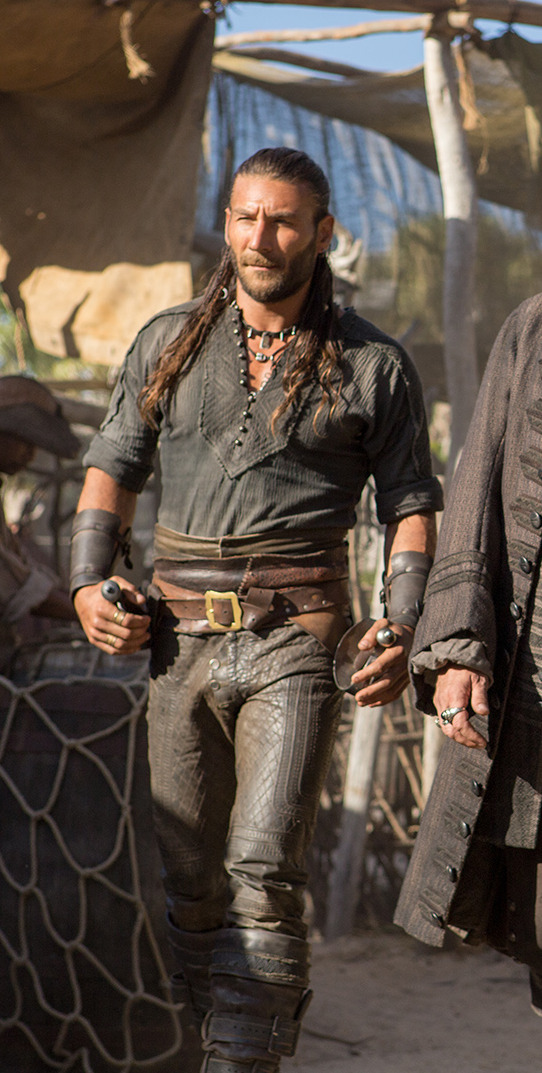
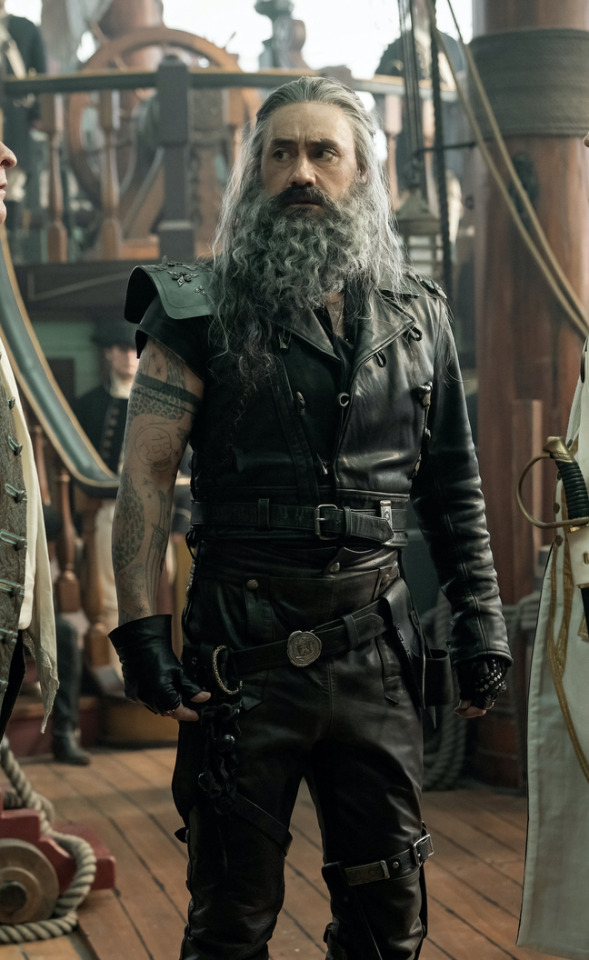
Here's the thing. Leather pants in period dramas isn't new. You've got your Vikings, Tudors, Outlander, Pirates of the Caribbean, Once Upon a Time, Will, The Musketeers, even Shakespeare in Love - they love to shove people in leather and call it a day. But where does this come from?

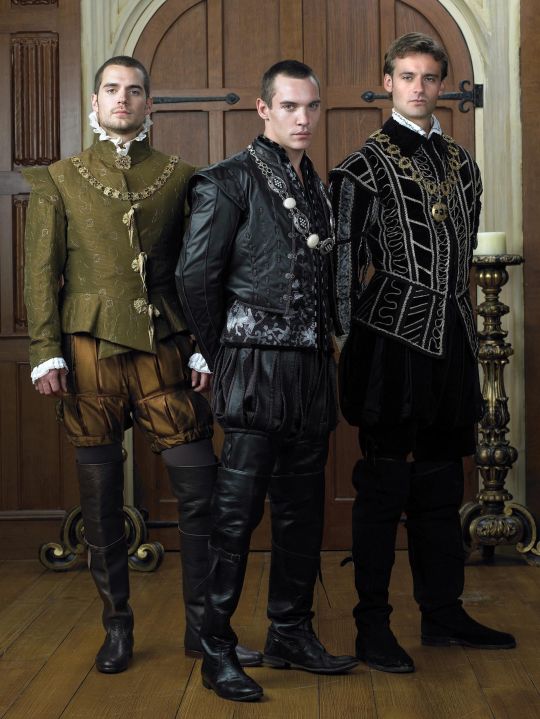
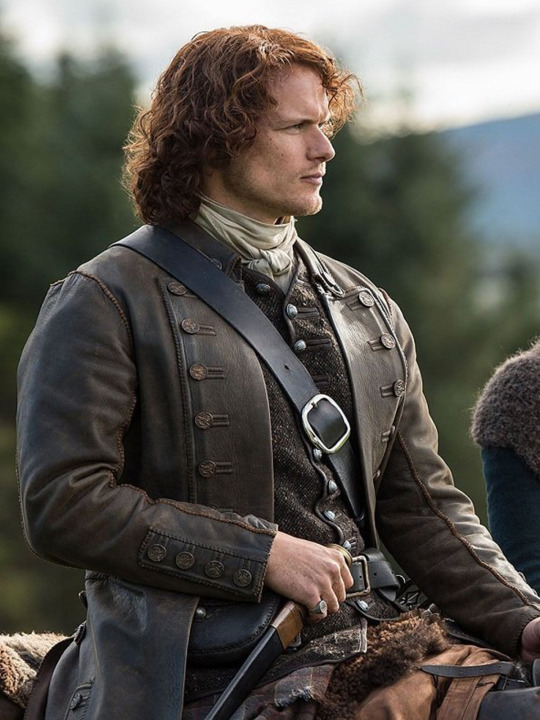

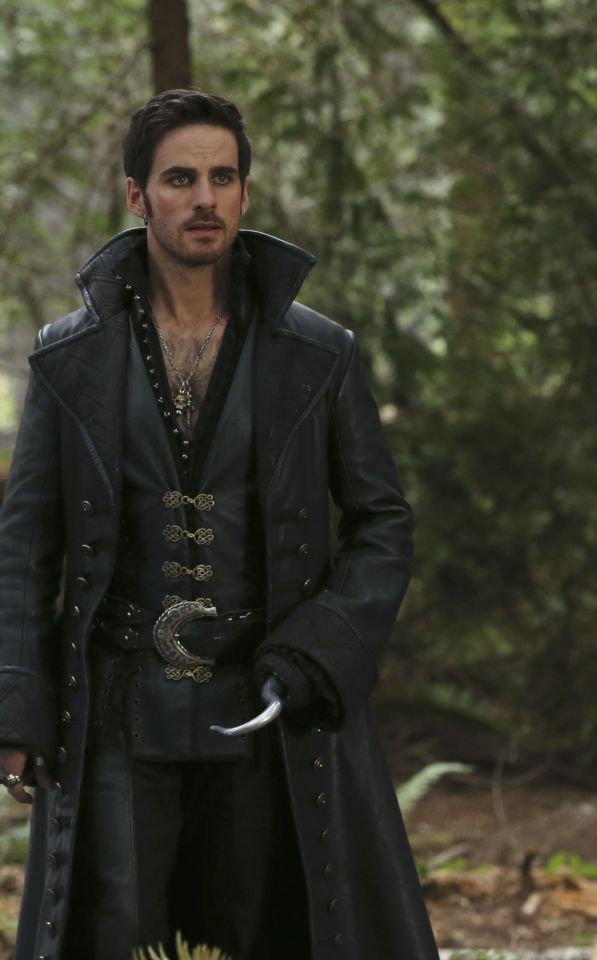
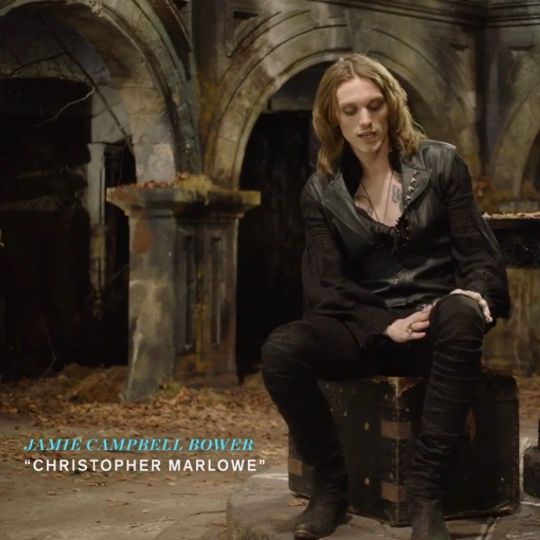
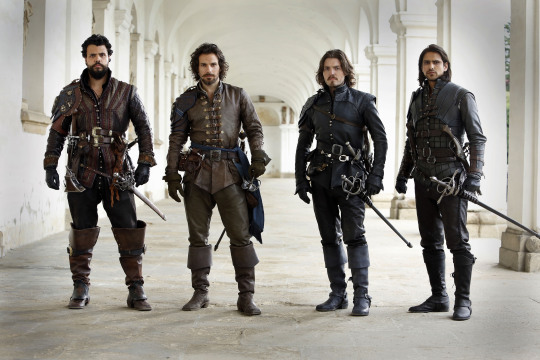

Obviously we have the modern connotations. Modern leather clothes developed in a few subcultures: cowboys drew on Native American clothing. (Allegedly. This is a little beyond my purview, I haven't seen any solid evidence, and it sounds like the kind of fact that people repeat a lot but is based on an assumption. I wouldn't know, though.) Leather was used in some WWI and II uniforms.
But the big boom came in the mid-C20th in motorcycle, punk/goth, and gay subcultures, all intertwined with each other and the above. Motorcyclists wear leather as practical protective gear, and it gets picked up by rock and punk artists as a symbol of counterculture, and transferred to movie designs. It gets wrapped up in gay and kink communities, with even more countercultural and taboo meanings. By the late C20th, leather has entered mainstream fashion, but it still carries those references to goths, punks, BDSM, and motorbike gangs, to James Dean, Marlon Brando, and Mick Jagger. This is whence we get our Spikes and Dave Listers in 1980s/90s media, bad boys and working-class punks.


And some of the above "historical" design choices clearly build on these meanings. William Shakespeare is dressed in a black leather doublet to evoke the swaggering bad boy artist heartthrob, probably down on his luck. So is Kit Marlowe.
But the associations get a little fuzzier after that. Hook, with his eyeliner and jewellery, sure. King Henry, yeah, I see it. It's hideously ahistorical, but sure. But what about Jamie and Will and Ragnar, in their browns and shabby, battle-ready chic? Well, here we get the other strain of Bad Period Drama Leather.
See, designers like to point to history, but it's just not true. Leather armour, especially in the western/European world, is very, very rare, and not just because it decays faster than metal. (Yes, even in ancient Greece/Rome, despite many articles claiming that as the start of the leather armour trend!) It simply wasn't used a lot, because it's frankly useless at defending the body compared to metal. Leather was used as a backing for some splint armour pieces, and for belts, sheathes, and buckles, but it simply wasn't worn like the costumes above. It's heavy, uncomfortable, and hard to repair - it's simply not practical for a garment when you have perfectly comfortable, insulating, and widely available linen, wool, and cotton!
As far as I can see, the real influence on leather in period dramas is fantasy. Fantasy media has proliferated the idea of leather armour as the lightweight choice for rangers, elves, and rogues, a natural, quiet, flexible material, less flashy or restrictive than metal. And it is cheaper for a costume department to make, and easier for an actor to wear on set. It's in Dungeons and Dragons and Lord of the Rings, King Arthur, Runescape, and World of Warcraft.

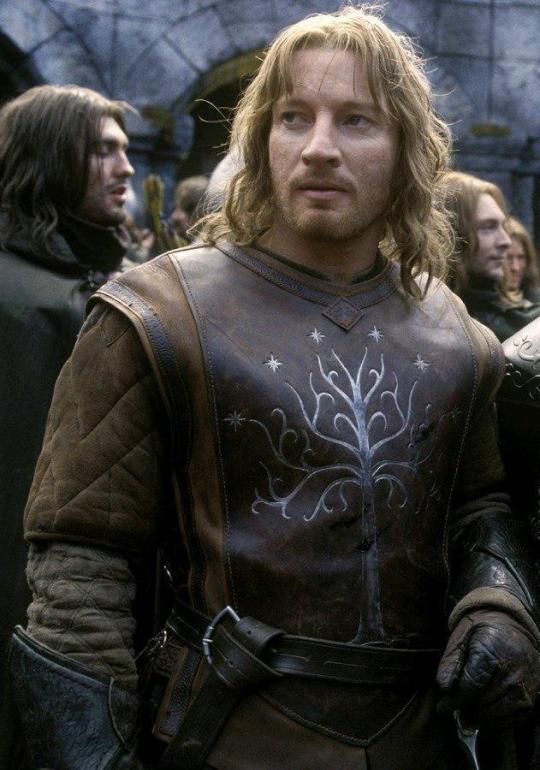
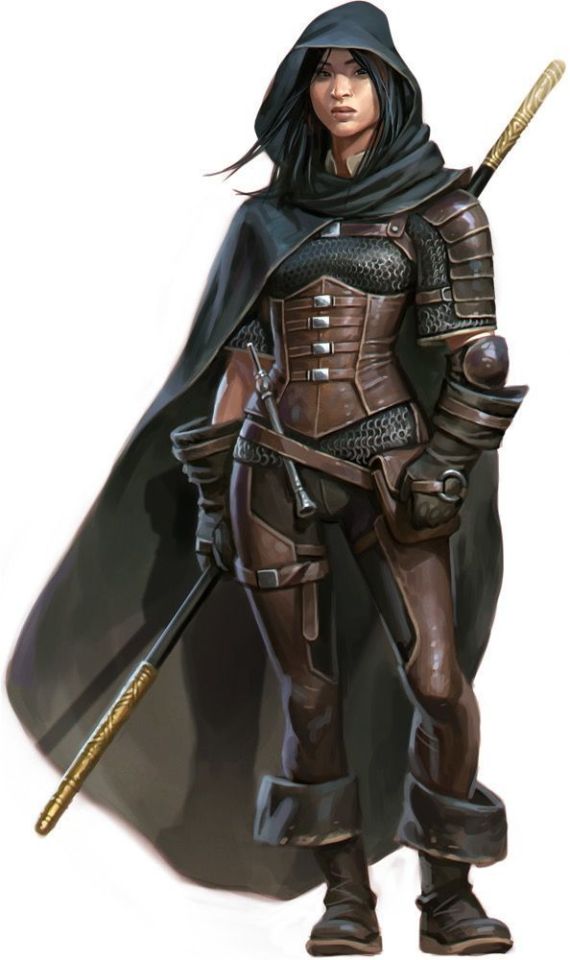
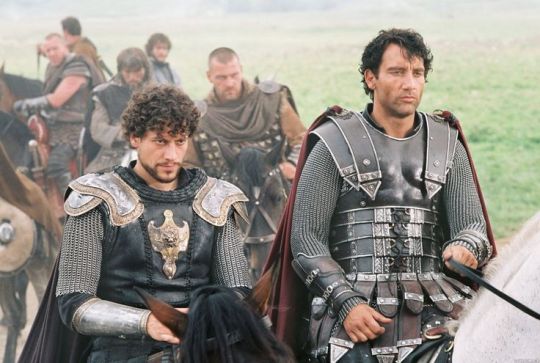

And I think this is how we get to characters like Ragnar and Vane. This idea of leather as practical gear and light armour, it's fantasy, but it has this lineage, behind which sits cowboy chaps and bomber/flight jackets. It's usually brown compared to the punk bad boy's black, less shiny, and more often piecemeal or decorated. In fact, there's a great distinction between the two Period Leather Modes within the same piece of media: Robin Hood (2006)! Compare the brooding, fascist-coded villain Guy of Gisborne with the shabby, bow-wielding, forest-dwelling Robin:

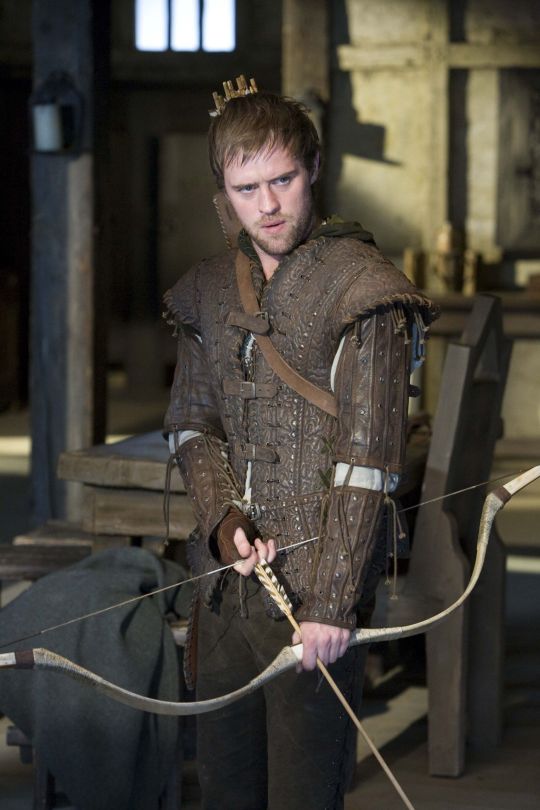
So, back to the original question: What's the difference between Charles Vane in Black Sails, and Edward Teach in Our Flag Means Death?
Simply put, it's intention. There is nothing intentional about Vane's leather in Black Sails. It's not the only leather in the show, and it only says what all shabby period leather says, relying on the same tropes as fantasy armour: he's a bad boy and a fighter in workaday leather, poor, flexible, and practical. None of these connotations are based in reality or history, and they've been done countless times before. It's boring design, neither historically accurate nor particularly creative, but much the same as all the other shabby chic fighters on our screens. He has a broad lineage in Lord of the Rings and Pirates of the Caribbean and such, but that's it.
In Our Flag, however, the lineage is much, much more intentional. Ed is a direct homage to Mad Max, the costuming in which is both practical (Max is an ex-cop and road warrior), and draws on punk and kink designs to evoke a counterculture gone mad to the point of social breakdown, exploiting the thrill of the taboo to frighten and titillate the audience.
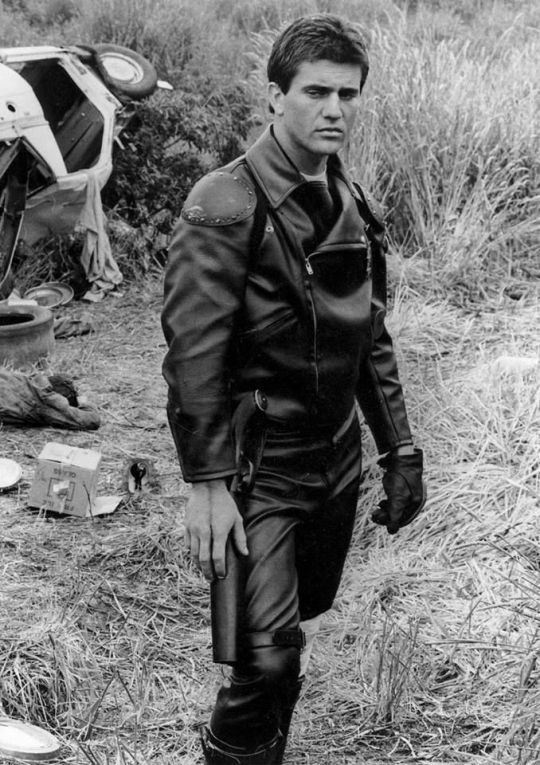
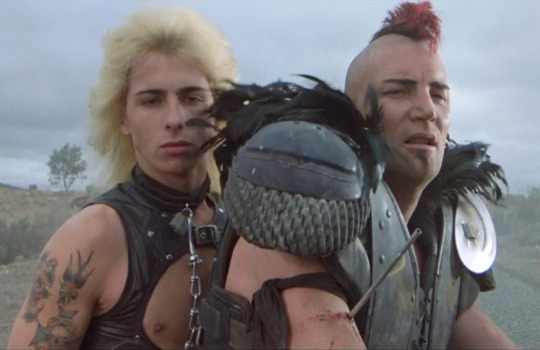
In particular, Ed is styled after Max in the second movie, having lost his family, been badly injured, and watched the world turn into an apocalypse. He's a broken man, withdrawn, violent, and deliberately cutting himself off from others to avoid getting hurt again. The plot of Mad Max 2 is him learning to open up and help others, making himself vulnerable to more loss, but more human in the process.

This ties directly into the themes of Our Flag - it's a deliberate intertext. Ed's emotional journey is also one from isolation and pain to vulnerability, community, and love. Mad Max (intentionally and unintentionally) explores themes of masculinity, violence, and power, while Max has become simplified in the popular imagination as a stoic, badass action hero rather than the more complex character he is, struggling with loss and humanity. Similarly, Our Flag explores masculinity, both textually (Stede is trying to build a less abusive pirate culture) and metatextually (the show champions complex, banal, and tender masculinities, especially when we're used to only seeing pirates in either gritty action movies or childish comedies).
Our Flag also draws on the specific countercultures of motorcycles, rockers, and gay/BDSM culture in its design and themes. Naturally, in such a queer show, one can't help but make the connection between leather pirates and leather daddies, and the design certainly nods at this, with its vests and studs. I always think about this guy, with his flat cap so reminiscient of gay leather fashions.

More overtly, though, Blackbeard and his crew are styled as both violent gangsters and countercultural rockstars. They rove the seas like a bikie gang, free and violent, and are seen as icons, bad boys and celebrities. Other pirates revere Blackbeard and wish they could be on his crew, while civilians are awed by his reputation, desperate for juicy, gory details.
This isn't all of why I like the costuming in Our Flag Means Death (especially season 1). Stede's outfits are by no means accurate, but they're a lot more accurate than most pirate media, and they're bright and colourful, with accurate and delightful silks, lace, velvets, and brocades, and lovely, puffy skirts on his jackets. Many of the Revenge crew wear recognisable sailor's trousers, and practical but bright, varied gear that easily conveys personality and flair. There is a surprising dedication to little details, like changing Ed's trousers to fall-fronts for a historical feel, Izzy's puffy sleeves, the handmade fringe on Lucius's red jacket, or the increasing absurdity of navy uniform cuffs between Nigel and Chauncey.
A really big one is the fact that they don't shy away from historical footwear! In almost every example above, we see the period drama's obsession with putting men in skinny jeans and bucket-top boots, but not only does Stede wear his little red-heeled shoes with stockings, but most of his crew, and the ordinary people of Barbados, wear low boots or pumps, and even rough, masculine characters like Pete wear knee breeches and bright colours. It's inaccurate, but at least it's a new kind of inaccuracy, that builds much more on actual historical fashions, and eschews the shortcuts of other, grittier period dramas in favour of colour and personality.
But also. At least it fucking says something with its leather.
#everyone say 'thank you togas' for not including a long tangent about evil rimmer in red dwarf 5x05#Our Flag Means Death#Togas does meta#and yes these principles DO fall apart slightly in s2 and i DON'T like those costumes as much#don't get me wrong they're fun and gorgeous - but generally a bit less deep and more inaccurate. so. :(#I'm not sure this really says anything new about Our Flag but I just needed to get my thoughts out#i hate hate hate Gritty Period Drama costumes they're so boring and so ugly and so wrong#god bless OFMD for using more than 3 muted colours and actually putting men in heels (and not as a shorthand for rich/foppish villainy) <3#looking at that Tudors still is insane like they really will go to any lengths to not make men feel like they've got bare legs XD#image descriptions in alt text#and yes i DID just sink about two hours into those so you'd better appreciate them
1K notes
·
View notes
Note
would you happen to have any more headcanons related to octo valley/canyon culture? i’m a very big fan of the way you portray agent 8 and i’m curious about your headcanons for the area that she’s from
Octolings don't experience senescence like ancestral octopuses do, but there's still historically been a high maternal mortality rate for related reasons. Due to this, it's common in many Octo cultures to not be raised by one's own parents.
In Octo Valley/Canyon, there is a strongly established and heavily used state foster system. Most of its residents are from parents who were encouraged to prioritize their careers over all else, and the majority of these children are pushed into the military training program. It's statistically likely (though not definite) that Eight was raised here.
Due to long-term birth rate decline, larger & larger amounts of Octarians have been created from limb cuttings to fill out the workforce. The military can't recruit enough women anymore.
Traditional gender roles dictate that women (esp. working class) do physical labor, but it's not necessarily a matriarchal society.
Occupants of the underground Octoling world are fairly diverse in terms of ancestry, but there has been a notable amount of cultural assimilation, especially directly after the end of the war.
It's likely that Eight is descended from multiple different groups of Octolings who came from somewhere else originally, and were forced underground a few generations ago. It's also likely that she was raised with no connection to their cultures. If she reconnected to anything, she learned about it from surface-dwellers.
A fair amount of music, dance, fashion, and other artforms on the surface either originated from or were heavily developed by underground-dwelling Octolings. Though this has been especially true recently due to migration, there's always been exchange as things were smuggled across borders.
598 notes
·
View notes
Text
Researching as a Writer
Start Broad
begin with a list of more general topics and get specific as you go.
for example, research for a historical fantasy novel might follow a chain that looks like this:
life in the 1700s -> life in 1700s france -> 1700s french etiquette and lifestyle depending on class -> 1720s french fashion for middle and upper-middle class women.
starting with a general understanding of the topic you want to cover and narrowing down to specifics will make it easier to build on your knowledge as you go.
Think Critically
consider the source. if it doesn’t cite primary sources (for example, letters and photographs from a specific era and location), what sources does it cite? follow those sources if possible.
is the information reliable? is it provided by an educational institution or an expert on the subject?
who is the author? do they present any bias? what do they have to gain by promoting a specific mindset or conclusion? has any of their research been debunked?
Anecdotes
in general, anecdotal evidence is not sufficient for academic writing. luckily for you, this is a fiction writing page, and anecdotal evidence is usually fine!
work with a combination of scholarly sources and personal experience. if you’re trying to depict a specific health condition, you might consult medical sources about the technical details of the condition, as well as seeking firsthand accounts from people who have that condition.
remember that people are not monolithic! there are often forums online where people are more than happy to discuss their experiences; cross-consult these for common elements.
Lists
keep track of your sources!! if you ever need to consult something later on, it will be way easier to open a list of resources than go digging through your search history.
additionally, if you come across lists of sources compiled by other people, save those!! you are probably not the first person to research the specific topic you’re looking into, and there are entire websites dedicated to gathering research!
wordsnstuffblog.com/research has compilations of sources for everything from writing injuries to global period pieces by century.
Resources
if you can, check out your school or public library’s websites! they will often compile scholarly resources to access for free.
look for open access or open source sites like project gutenberg that archive and digitize historical documents and other works. scienceopen and the directory of open access journals are more of these. search using keywords!
keep an eye out for websites made specifically for educational purposes (those with .edu at the end of their addresses).
#🌿 writing#writing tips#writing advice#writing resources#i'm trying to compile some instagram posts on here for easier reference#writing research
893 notes
·
View notes
Text
BLs with Strong Historical Elements
Costume dramas, historical BLs, and BLs with time travel or flashbacks to historical locations & times.
These are in order of my personal preference, best at the top.
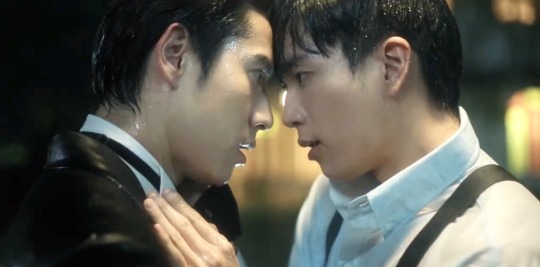
I Feel You Linger in the Air
2023 Thailand
IFYLITA is an exquisite BL, from filming techniques to narrative framework (much like Until We Meet Again). It's about a gay man from our time who falls into the past, becomes a servant to a noble house, and falls in love with the heir. It turns out this has all happened several times before. Steeped in history and family drama it edges into lakorn (but not as much as To Sir With Love and with way less scenery chewing). This is an elegant and classy soulmates BL... from Thailand which normally doesn't even try for classy. The main couple (both as a pair and as individuals) were excellent, particularly Bright (Yai) whose eye-work acting style is a personal favorite of mine. Pity about the ending. Oh it wasn’t that sad but it wasn’t good either. This show could easily have earned a 10/10 from me except that it fumbled the… erm… balls in the final quarter. Argh. Whatever.
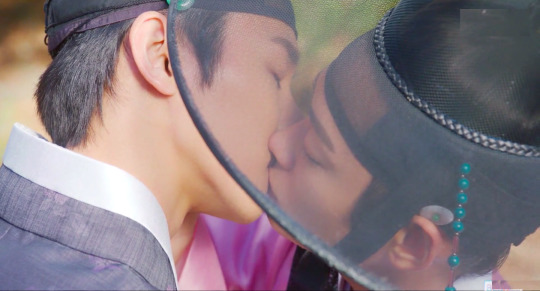
Nobleman Ryu's Wedding
2021 Korea - WeTV
A boy cross-dresses to take his runaway sister's place as a bride to a shy scholar, turns out they like being married. A historical setting allowed this BL to use some seriously old fashioned romance tropes (arranged marriage, evil step-sisters, Cinderfella) but also modern BL stylings like fake relationship & secret identity (drag) plus some cute gay panic. It reminded me of 12th Night more than anything else which just happens to be my favorite Shakespeare play. For all these reasons, I adored it.
(the ghat kiss!)

Tinted With You
2022 Korea - Viki
Fun stylish time travel meets portal fantasy with a likable cast, historical setting, and two actual kisses that mitigate the rough plot and issues around anachronisms.

Word of Honor
2021 China (censored) - Viki/YouTube?
I don’t rec Chinese stuff often, because I believe in censoring the censors, but this show is one of my favorites of the post 2016 censored bromances. It’s two murder-gay assassins (pining sunshine/tsundere), and they are so insanely gay for two boys who will never be allowed to kiss. Tropes include: wuxia, soulmates, paranormal, historical, and fantasy elements.
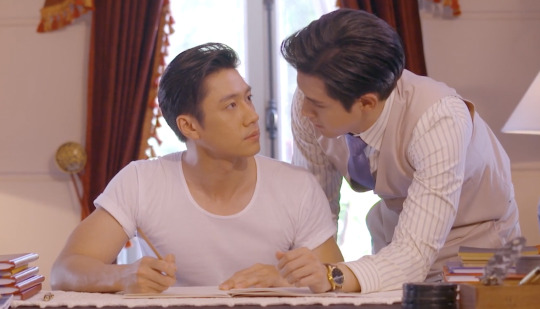
To Sir, With Love AKA Khun Chai
2022 Thailand - YouTube?
This is a true lakorn (basically Thai tellenovella or soap opera) with scenery chewing performances, especially from the mother characters. Gone With the Wind + Days of Our Lives but gay. That said? I loved it: A glorious central brother relationship (the best, made me cry), het romances, class divide + gay *gasp* main romance - oh my word, the campy drama of it all! Arranged marriage, rebellion, cut sleeves, over-the-top death with curses and regrets, beautiful if inaccurate costumes, secrets unraveling, cover ups, sparkle murder, sex herbs, coils within coils including snakes and murderous green metallic sequins (is anything gayer on this earth?). It’s a WILD ride but it does end happy for our gay boys. A man cries when he finds DEATH GLITTER. Come on! You haffa watch it. That said, like Manner of Death I struggle to rate something on a BL scale when it patently isn’t a BL. So I ended up giving this exactly what I gave that show, 7/10 I enjoyed it a whole lot, but not as a BL.
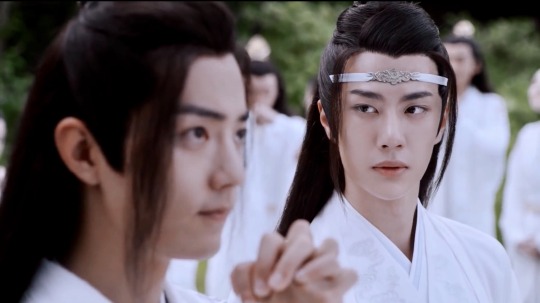
The Untamed (Special BL Edition)
2020 China (censored) - YouTube
Censored wuxia bromance, amorphous ending. Probubly the best known BL of its kind out of China and responsible for bring many fans to the BL side.

Our Skyy 2: Never Let Me Go
2023 Thailand - YouTube
I was nervous to watch this PondPhuwin vehicle but I liked it a lot! Doomed soulmates + paranormal time travel to fix the past. I’m happy for the outfits and the dancing (if not the singing). It’s not a bad premise and it’s nice to see GMMTV lean into its high production values for a change. I'd adore a full historical starring these two and this was definitely the best of the second series of Our Skyy. I don't think you have to have watched the original Never Let Me Go to enjoy this.
Legend of Long Yang: Rebirth
2017 China
Gaga
Whipping boy trope... literally, servant character takes the strap for the prince, who then makes him his bodyguard and lover when he becomes king. Low budget historical, comes off as kind of cosplay wuxia version of Irresistible Love, but we get (in the credits) an actual kiss, and they both live. So yay for small mercies.

The Director Who Buys Me Dinner
2023 Korea (historical flash backs)
iQIYI
A new employee at a film company encounters a director who claims to have lived 300 years and insists that they have to date (eat, hug & kiss) if baby doesn't want to die. It has a lot of Japanese elements, not the least of which are: an office setting, the fact that every character in this show is unhinged, and a killing of the gays. Featuring a gorgeous & stellar cast, TDWBMD should have utilized them less for melodrama and more for chemistry. This BL surprised me by going there with a lipstick mark AND an actually gay idol. But (you knew there was a but) while it's a unique twist on an office romance it is NOT a unique twist on the doomed red thread trope, resulting in it feeling less than the sum of its parts and ultimately unsatisfying. This might have also had to do with the fact that this was one of those KBLs where I felt how very short it was the whole time I was watching, like I was missing something constantly, in every episode. Worth watching for some but seriously flawed.
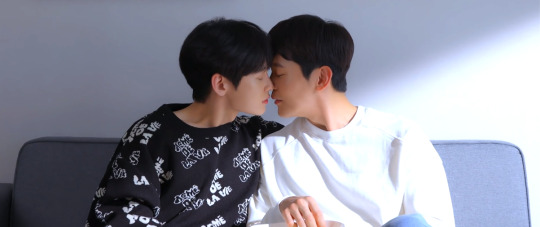
First Love Again
2022 Korea (historical flash backs) - Viki
A popular novelist who remembers his past lives meets his soulmate for the third time, only to find she has been reincarnated into the body of a man. This one started out a touch mean-spirited, but we eventually got a good kiss. The confession/rejection scene was justified and the reconciliation and ending was... fine. All in all, the pacing felt rushed and the romantic arc was underdeveloped. They go from like to love to boyfriends in a red hot minute. But that’s par for the course with Korea’s short form. If you don’t mind a heavy does of melodrama in your BL this one has a solid story with a strong concept that’s well acted and produced, making it a classic KBL with better than average chemistry but ultimately a touch forgettable.
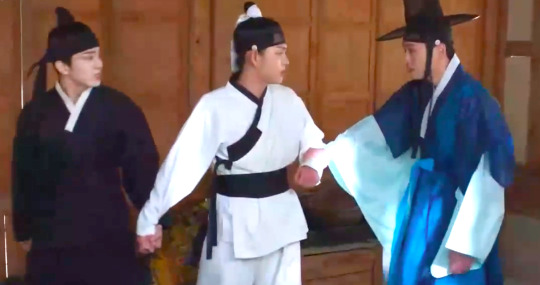
Love in Spring AKA Spring of Crush
2022 Korea
This show was all over the place with uneven acting, narrative, and focus (sometimes it wanted to be a slapstick comedy, sometimes a depressing melodrama) which meant no one, actors or viewers, took anyone or anything seriously.... AND it’s a bromance. I was left wondering if SalHyung is now code for “they were roommates” in Kdrama historicals but otherwise largely apathetic and unimpressed. Korea, I now know you can do better. Do better.
Mermaid's Jade
2019 China (censored-esk) - Gaga
Kills the gay.
The Male Queen: Han Zi Gao
2016 China - Gaga
Kills the gay. Schrodinger's BL, both a BL and entirely not one at the same time.
Diary of Heong Yeong Dang
2014 Korea
Kills the Gay
I was gonna do a top 10 list, but there aren't enough by my metrics, so many end sadly.
This post at the behest of @verymuchof thank you for the idea!
Dated April 2023, includes only BLs that had finished their run by that date. Not responsible for cool costume flix that come after that. But you should check the comments to see if any have been added by others!
I might have missed a few that only have time historical elements since I don't always track those.
Also I would like to point out a decided lack of Japan on this list. My ninja yaoi consuming tiny past self is VERY upset about this void.
WHERE ARE MY GAY NINJAS??!!!
(source)
#historical bls#time travel bls#bls with historical elements#korean bl#chinese bl#thai bl#I Feel You Linger in the Air#Nobleman Ryu's Wedding#Scholar Ryu's Wedding#Tinted With You#Word of Honor#Khun Chai#to sir with love#The Untamed#Never let me go#Legend of Long Yang#The Director Who Buys Me Dinner#First Love Again#Love in Spring#Spring of Crush
183 notes
·
View notes
Note
Hiya!
Love your blog! So much cool info here. I don't know if this is the kind of thing you are interested in or know much about but I'm making a cosplay of Mary from the BBC Ghosts. She supposedly died in the early 17th century but I can't find anything on the blue bodice/waistcoat she is wearing. I think it is closer to 19th century stays? Anyway, I get it's not 100% historically accurate costume, just wondering. Thanks!
Hi, Anon! And thank you so much!
I haven't watched the show, but I checked out the outfit and here it is for those who also didn't know it before:

A quick look at the Ghosts wikipage of her tells she was an English peasant.
I ended up falling into a bit of research rabbit hole (which is why it took me this long to answer). The evolution of working class garments from Elizabethan era to 1700s ended up being very interesting and surprisingly complicated. It doesn't make it easier that there's very little info on the subject, especially regarding English working class. It's much easier to find info on Dutch and Flemish working class clothing, as the Dutch golden age/baroque art was very interested in depicting working class people, the style also provides abundance of detail. English artists were much less interested in painting common people.
To make the rest make any sense I think it would be useful to outline the evolution of garments used in 16th to 18th century. In 1500s kirtle (here's a post where I talk about what kirtle is and it's evolutiona mong other things) was becoming more and more structured, eventually it's bodice becoming fully boned. Lower classes wouldn't bone their kirtles but reinforce them with several layers of canvas or buckram. In the first half of the century a short wool coat was sometimes used under the outerwear far warmed called petticoat. It was the Little Ice Age after all. Two boned or highly stiffened kirtles started to be used on top of each other, the first layer being made from cheaper materials and acting as the actual supporting layer, and the one on top of it from more expensive materials, stiffening (not necessarily boning) making sure the fabric is structured and without wrinkles. In the latter half of the century petticoat started to refer to the undergarment kirtle. Petticoats usually were a full dress like kirtle, though there's references of "petticoats without the upper bodies" so petticoats with only the skirt were also used as undergarments.
It gained the connotation of a simple and not very fancy garment, which is why the lower class kirtles started to be called petticoats by late 1500s. Lower classes might also wear two layers of petticoats, often in contrasting colors, probably in cold weather and then one layer in hot weather. The bodice and skirt also could be contrasting colors. The outer petticoat had almost always lacing in the front, but the petticoat under it might have lacing in the back or side so it's fabric could be seen under the lacing over it. At least Dutch and Flemish women would usually have a stomacher of contrasting color under the front lacing if they didn't have a petticoat under. Very wide lacing which showed off the fabric beneath was typical (but not necessary) for those and the German speaking areas. Petticoats would often have attachable or sewn-in sleeves like kirtles since Middle Ages, so that they could be worn as undergarment without sleeves and outer garment with sleeves if necessary.
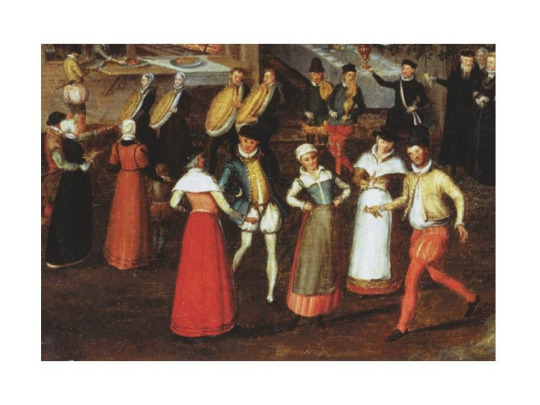
An example from 1570s England. Two of the three peasant women in the front are wearing petticoats with bodices made from different fabrics.

An example by Flemish painter from around 1560s/70s. The left-most woman is clearly wearing a soft stomacher under her petticoat and the woman in the very middle has attached sleeves as shown by the bulging shift in her arm pits.
Over the petticoats though working class women would often wear a looser sleeved over-garment which wasn't laced. Around Netherlands area it was a short jacket with widening hem at waist often called waistcoat, like on the right-most woman in above painting, though I'm not sure if that is actually contemporary term for it. In late 1500s England the over-garment seemed to be more commonly a full length gown open in the front with short or full sleeves, similarly as the fashionable outer garment of the upper classes but much simpler, but by early 1600s the waistcoat is most commonly depicted in England too. There were couple of important accessories. Partlet was in 1600s most often white linen, while in the earlier century woolen black partlets were also common (the woman in the middle of the Flemish painting above is wearing both). In 1500s and early half of 1600s the partlet had high collar with ruffle like shown in the above paintings and it was usually worn over the petticoat (though sometimes under) and under the waistcoat or similar over-garment. Apron was also very important for working women, and while most often it was white linen, wool and different colors like show in both paintings above were also common. Kercief, a (most often) white linen scarf pinned on shoulders, was also common, especially in England, as shown in the first painting and the one below.
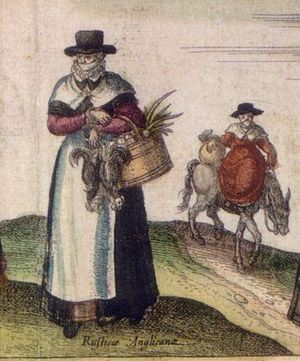
An English peasant from 1582 illustration wearing an open-fronted over-gown with short sleeves.
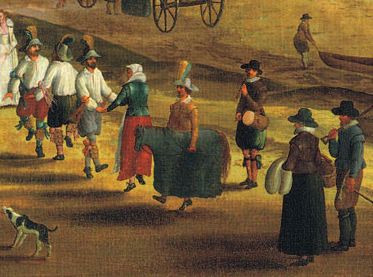
English peasants dancing from 1620s, while the women are wearing waistcoats.
In the fashion of the upper classes the bodice of the petticoat and the skirt of the petticoat started to appear as separate garments in late 1500s. A separate bodice was referred to as pair of bodies, or bodies, similarly to the bodice of the petticoat was referred to as upper bodies like I mentioned before. The word bodice actually derives from it. For clarity I will call the separate boned bodice as bodies. Like petticoat it was very much an undergarment, though could be used as a leisure wear in private. Like other supportive clothing that could be used as both under and over garments it also often had detachable sleeves. The full petticoat would fall out of use by the upper class by mid 1600s, but bodies wouldn't become universal as the structural layer yet, as the outer gown's bodice would often still be boned and used as the supportive layer. Working class women would use full petticoats till late 1600s, but separate bodies would become more widespread from early to mid century onward. Boning also would get adopted into working class clothing around mid century, though stiffening with fabrics or barely at all would continue to be common the whole century and still continue till early 1700s.
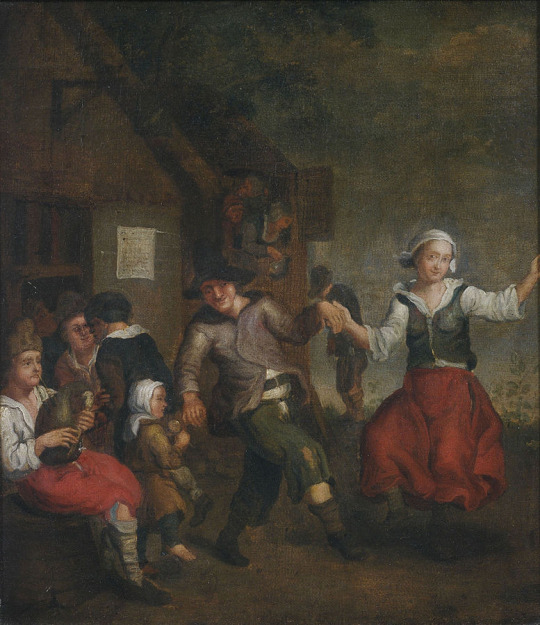
An example of bodies without boning on a peasant woman from the second half of 17th century Netherlands.
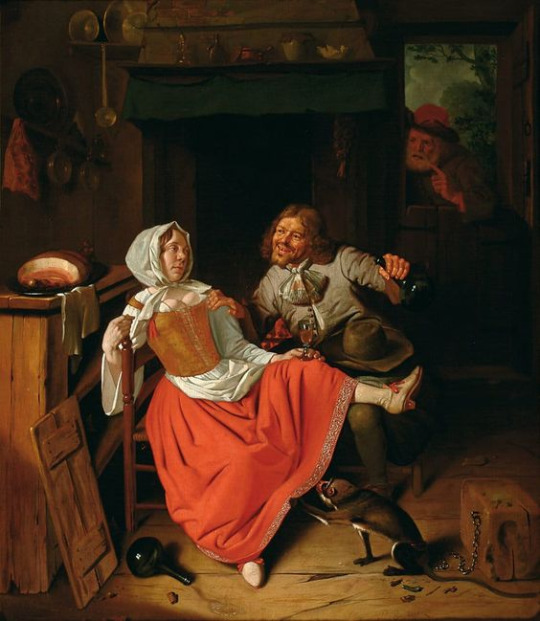
Working class woman with boned bodies from 1665-70, also Netherlands.
In 1680s there was a huge shift in the upper class fashion as mantua, completely unstructured garment, became extremely common and stays were developed from bodies to be it's supportive layer. Before that the boning was called stays, which alludes to the increasing distinction between outer and under clothing, as stays would be more of just separate boning rather than garment that could be used on it's own (though it could still be worn on it's own in some cases). In working class fashion the full petticoat fully disappeared by 18th century and the basic set of clothes was petticoat, supportive bodice without boning or stays (which would become almost universal during the century) and bed gown or jacket. Bed gown was short and very jacket-like, but a looser and t-shaped without the shoulder seem. Both were increasingly used regardless of weather.
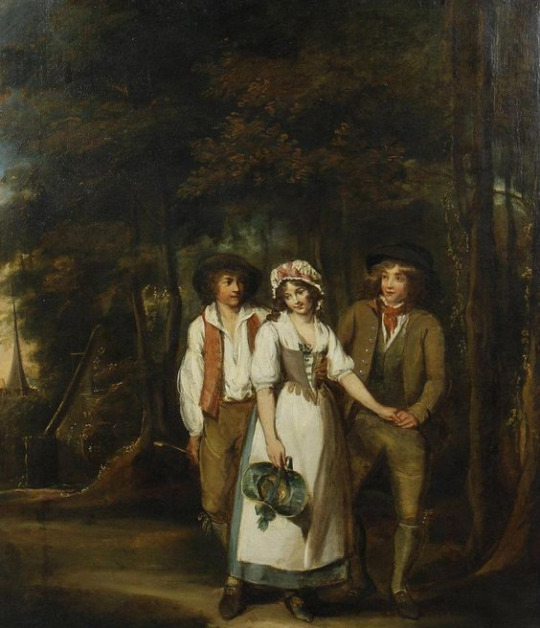
Stays as outer garment from around 1780s-90s.
I think that Mary's blue waistcoat/bodice most resembles 18th century examples. Specifically, the supportive laced bodices without boning, like in the examples below. Unfortunately I haven't found any info about them. The cut is simpler than stays and actually reminds me most about jackets/waistcoats without sleeves. I've read there was laced under-jackets used in 18th century, so I'm wondering if these bodices relates to that. Maybe likelier origin is that they evolved from the previous century working class bodies that didn't have boning. Mary's bodice however is cut very differently. The neckline is high unlike these 1700s bodices, which purpose was to lift the chest.

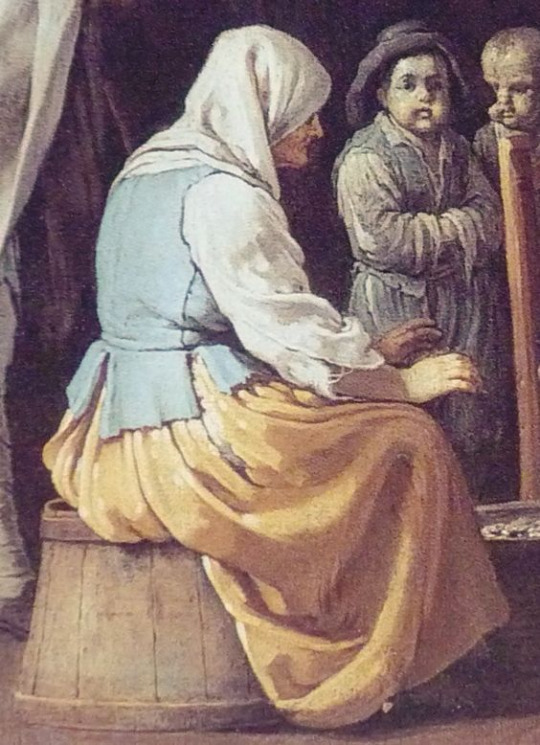
Firstly a Dutch painting from first half of 18th century and then Italian painting from 1721.
Because supportive garments became very much undergarments or at least the second lowest layer right after shift, even if nothing was worn on top of it, it really doesn't fit Mary's bodice. Though I maybe found an exception where stays are possibly worn on top of a sleeved waistcoat or maybe bed gown, but it's hard to say and I haven't seen any other examples of that.

A 1713 Dutch illustration of Brabant, Belgium, dress. The bodice part looks like it could be a bed gown or similar loose jacket-like garment with boned stays on top of it. With little detail and no color it's hard to say though. It could be also a boned jacket or jacket on top of stays.
There is actually a fairly well documented style around this era that does have long sleeved garment beneath and sleeves garment over it. In the latter half of the 17th century and more rarely in early 18th century paintings depict Dutch and Flemish working women wearing long sleeved garment and laced bodice or petticoat over it. I haven't really seen depictions outside of them, however it doesn't mean they don't exist, since as said in the beginning there's just overwhelmingly more lower class depictions in Dutch and Flemish art than in any other art. Still, there being examples of this style from 1700s, when it's very outdated and absent in working class and peasant depictions of art from other areas, where depicting working class is becoming more common, suggests to me that it's at least somewhat regional style.
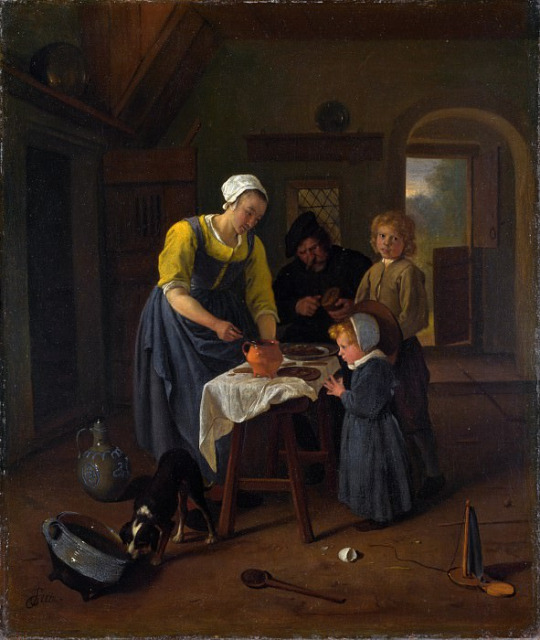
A Dutch painting from circa 1665.
In the above painting the woman seems to wear a full petticoat (the bodice and skirt are same color) with lacing on the front and what seems like a waistcoat under it. It's hard to say if the bodice is boned. This is a nice example as the partlet (the collar had mostly lost popularity by this time) is under garments unlike in most other depictions where it's on top of the bodice. We can then see that the sleeved garment is pinned and has fairly high neckline making it look a lot like the waistcoats of the time. It could be that they are not all the same garment. I would have rather guessed they were full petticoats with sewn-in sleeves before seeing this painting, but some of them still could be, especially the ones that seem more fitted. I haven't found any information about it, except one webside where it was called bed gown, which I think they definitely are not as they come earlier, are sometimes very fitted and often the shoulder seem of the sleeve is shown. Bodies and petticoats with detachable sleeves and waistcoats as over-garments are still frequently found in Dutch and Flemish paintings of the time, which makes me question why would they put especially waistcoat under the supportive layer? My little pet theory is that they need it for the warmth, but they want to protect it with a less expensive petticoat and/or bodies while working.
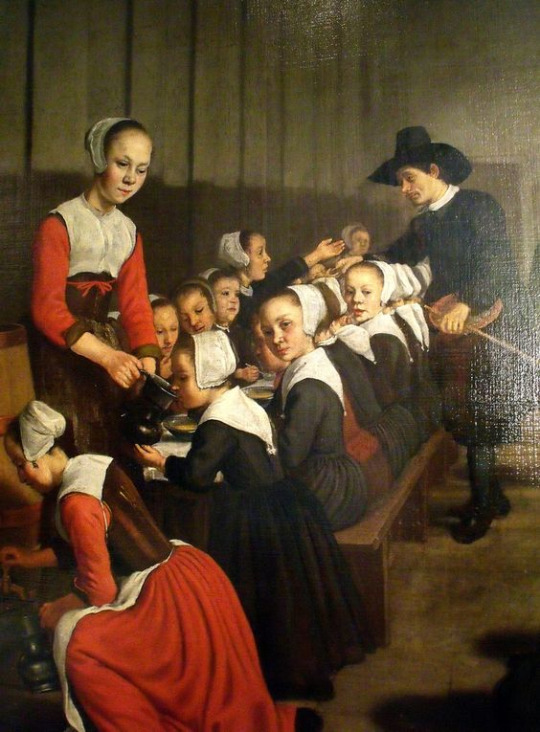
A Dutch 1659-60 painting. Here I think the women in red could be wearing sleeved petticoats or separate bodices under their bodies.
For Mary's outfit the issue is the peplum-type hemline on her blue bodice. It's very much absent in this era from bodies both boned and not, weather because the bodies end in waistline, which there's some depictions of like the one several pictures above, or the hem is under the petticoat. But I did find this one garment from the same era also depicted in Dutch and Flemish art mostly on older women. It has the peplum hem, but it's not bodies. All the examples I've seen are pinned close, so not supportive and definitely not boned. They are also cut differently. The shoulders are quite wide and the neckline high. It almost feels like sleeveless waistcoat. I found even less info on this style, so I can only guess.
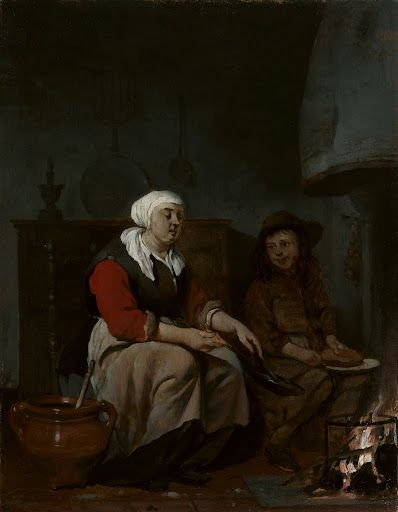
Dutch painting from circa 1650-55. The waistcoat/bodice has a hem here that extends over the gray petticoat unlike with other garments we've looked at.
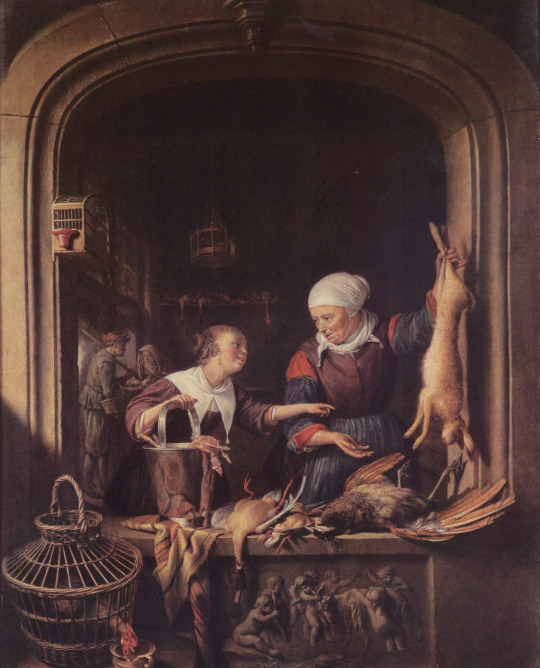
Dutch painting circa 1670. In the enlarge image you can just make out the seem of the undergarment.
I think Mary's clothing best reflects this specific style from this period of time. Her partlet also lacks the ruffle as later 1600s partlets usually do. Her apron is also gathered like those in the latter half of 1600s. Earlier aprons are usually not gathered as seen in the couple of first examples. The blue bodice I think is a mix between the sleeveless waistcoat-type garment seen in two above paintings and the separate or petticoat bodices which are not boned. It's laced and has narrow shoulders like the bodices, but it has high neckline and the hem over the petticoat like the sleeveless "waistcoats". The ruffles on her sleeves don't make sense in this time period. They could make more sense in 1700s. Over all it's actually pretty close in time and geographically to the time and place she's supposed to come from, even if it's not the way she'd actually dress if she was from early 1600s England.
#fashion history#historical fashion#historical clothing#historical costuming#bbc ghosts#working class clothing#peasant clothing#dutch golden age art#baroque#baroque fashion#elizabethan fashion#dress history#answers#ask
118 notes
·
View notes
Text
Fashion history resources?
researching fashion for the various time periods has been driving me a little crazy, particularly because when you search up historical fashion, the results overwhelmingly trend towards upper class women (usually aristocracy), then upper class/aristocratic men, then middle class men/women, with little representation of working class women and even less for working class men. (This obviously depends on time period and country; currently, I'm scrounging around for references for servants in 1660s France. Non-European fashion is even harder to research).
So, I figured it could be good to start a chain of resources on fashion history! Here's two that I've been using heavily in researching my current WIP:
Nicole Kipar's Restoration Costume Comes to Life
This truly lovely website which details costumes of the Restoration (1660s England, mostly), and has a gallery collection of paintings of working class people with annotations on what they're wearing, the time period, and their specific social role (i.e., poor peasant, affluent peasant, market trader). It's designed for costume makers, but it's also useful for artists or writers. There are five parts: working class men and women, women of the gentry and aristocracy, men of the gentry and aristocracy, accessories, and a costume focus.
Fashion History Timeline
It is what the name suggests: open source fashion history timeline from prehistory to (afaik) 19th century. I haven't explored much beyond 1660s yet, and generally does seem to focus on fashion of the upper classes, but it's already been so useful.
If anyone has any websites/books/other resources to add, please do!
956 notes
·
View notes
Text
Fictional worldbuilding
I have this list I compiled of topics for developing of countries, whether fantasy based or not, and it seems to be a useful resource to share. Feel free to use this list to develop your own lore, but DO NOT claim it as your own or repost. It's pretty long, but I think it covers a lot of relevant topics for worldbuilding.
General
∎ Country name
- Etymology if possible
- Reasons for the name
∎ Does it take inspiration for a historical time period, aesthetic, or culture
∎ What sort of government is it
Important Places
∎ Main cities
- Layout of the city
- Economic or historical importance
∎ Other cities and places of importance
- Ports
- Mine cities
- Scholarly cities
∎ Seasonal or turistic places
Climate and Terrain
∎ Important lakes, rivers, mountain chains or other geographically relevant places
∎ Seasons
∎ Climate in general
∎ How does the terrain affect daily habits
∎ Important plants
- Agriculture
- Crops for export
∎ Important animals
- Livestock
Government
∎ System of government
- Nobility/aristocracy
-- Titles and inheritance/eligibility of titles
- Merchant class
∎ Current and past rulers
Social customs
∎ Entertainment
- Common forms of entertainment
- Games
- Cultural/social forms of enterteinment (go to parties/go to the movies/go out to eat/etc)
∎ Seasonal entertainment
- Vacations
- Seasonal high class customs
∎ Customs regarding reading and books
∎ Customs towards addictive substances
- Alcohol
- Tobacco
- Opioids
- Other stuffs
∎ Education and educational system
∎ Houses
- Home layouts
- Common things in houses
∎ Rites of passage
- Age to be presented as adult to the society and customs regarding it
∎ Manners and behaviour in public
∎ Religion
- Possible gods
- Holidays
- Festivals
∎ Customs regarding music
- Musical instruments
Notions of family
∎ Inheritance laws
∎ Marriage and concepts of marriage
- Marriage rituals
- Who is allowed to wed who
- Divorce
- Customs toward conjugal and domestic violence
- Polygamy
-- Extraconjugal affairs
--- Bastards
∎ Adoption
∎ Division of domestic labor and roles
Economy
∎ Coin and values
∎ Important internal products
∎ Main imports
∎ Main exports
∎ Important commercial relations
Fashion
∎ Common feminine fashion
∎ Common masculine fashion
∎ Concepts about clothing
- What is seen as vulgar
- What is seen as desirable
∎ Fashion and rites of passage
∎ Hairstyles and adornments
Names and language
∎ Base language
∎ Linguistic influences
∎ Working of names
- Family names
-- Patronymic and matronymic
- Personal names
Magic and technology
∎ Magic
- Practice of magic
- Permissions within magic
- Common and uncommon forms of magic
∎ Magic creatures of importance
∎ Level of technology
∎ Daily uses of technology
#worldbuilding#fantasy worldbuilding#worldbuilding tools#fantasy#high fantasy#magic system#world building#fantasy writing#fantasy world#urban fantasy#creative writing#fanfic writer#writerblr#writers block#writing#writers of tumblr#fantasy country#fanfic#fanfiction#fic ideas#fanfics#resources#for future reference#useful#helpful#for reference#writing tool#writing tools#writing resources#writing research
1K notes
·
View notes
Text
let's be more positive about books for a while! here are some queer historical romance novels that i've been rereading recently that i think do something interesting with making characters feel historical in their mindset and worldview, but are also fairly progressive, diverse queer books that are, frankly, a delight to read
this is by no means exhaustive and to be honest i could put almost anything by cat sebastian or kj charles on a list like this so this is purely the highlights of what i've reread in the past week to take my mind off work, and why i think they're interesting from this specific angle
cat sebastian, the ruin of a rake (turners #3)
this is technically the third in a trilogy but they're only very loosely connected, so you don't need to have read the others if you don't care about knowing who all the background characters are. the others are also good though
why it's interesting: features a character who has had to painstakingly study and learn the rules of polite society in order to claw his way up to respectability, and is now deploying those skills to help another man repair his reputation. shows the complexity of those rules, the social purposes they serve, and the work that goes into living by them, as well as the consequences of breaking them. also explores some of the financial side of aristocracy, and features a character with chronic illness (recurring malaria following repeated infections as a child in india) whose feelings about his illness are very relatable without feeling overly modern.
kj charles, society of gentlemen series.
this trilogy is closely related plot-wise and best read in order. all three explore cross-class romances and characters struggling to reconcile their political views and personal ethics with their desires, in the aftermath of the peterloo massacre, with a strong focus on the political role of the written word. first book is long-lost gentleman raised by seditionists / fashion-minded dandy teaching him to behave in society; second book is tory nobleman submissive / seditious pamphleteer dominant who've been fucking for a year without knowing the other's identity; third book is lord / valet and all the complicated dynamics of consent there with a generous side-helping of crime.
why they're interesting: close attention to the history of political printing and the impact of government censorship and repressive taxes on the freedom of the press; complex ideological disagreements that aren't handwaved as unimportant; examination of trust, consent, and social responsibility across class differences and in situations with problematic power dynamics; most of the characters are progressive for their time without feeling like they have modern attitudes. the second book, a seditious affair, deals most strongly with the revolutionary politics side of things, but all tackle it to some extent.
kj charles, band sinister.
look i'm probably biased because this might be my favourite KJC. it's a standalone about a pair of siblings: the sister wrote a gothic novel heavily inspired by their mysterious and scandalous neighbour whose older brother had an affair with their mum (causing scandal); the brother is a classics nerd. the sister breaks her leg on a ride through their neighbour's estate and can't be moved until she heals so they both have to stay at the house and find out if the neighbour is really as scandalous as he seems.
why it's interesting: discussion of atheism and new ideas about science and creation (very shocking to the brother, who is the viewpoint character); details of agriculture and estate management via main LI's attempt to grow sugar beet, as well as the economics of sugar (including references to slavery); "unexpurgated" latin and greek classics as queer reference points for a character who nevertheless hasn't quite figured out he's queer; material consequences of society scandal
bonus: wonderful sibling dynamic and a diverse cast including a portugese jewish character, which i don't think i've seen in a book before
i will add to this list as i continue to reread both of their backlists! (bc i have read them all enough times and in close enough succession that they blur together in my head unless i've read them very recently)
121 notes
·
View notes